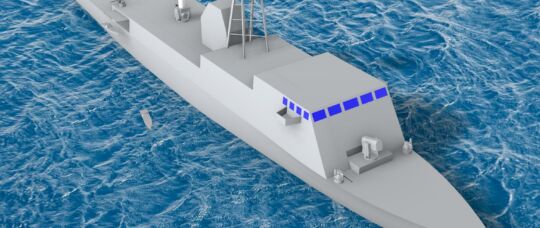Designers: Kyle Murphy, Gabriel Allen, Alex Resio, Jacob Dillistin
Vessel Type: Minesweeping Countermeasure Mothership
Vessel Mission:
Provide a new method for handling mine countermeasure operations with the use of mine countermeasure units-remote/autonomous (MCU-RAS). The use of MCU-RAS in mine countermeasures allows the coverage of larger minefield areas as compared to traditional minesweepers while minimizing the risk to personnel and naval assets.
Characteristics and Features:
• Overall Length: 108.75 m
• Beam: 14.5 m
• Depth: 9 m
• Max Speed: 32 kts
• Cruising Speed: 16 kts
• Installed Power: 43.4 MW
• Range: 4000 nm
• Compliment: 76 persons
• Endurance: 30 days
• Service Life: 40 years
• Full Load Displacement: 3540 tonne
• Platform for deployment, recovery, and maintenance for a fleet of 30 MCU-RAS
• Launches all MCU-RAS in less than 3 hours, recovers in less than 12 hours
• Flight deck for helicopter support
View Presentation
Visit our Junior Class Small Vessel Design Project page to view all of this year’s projects.
About Junior Class Small Vessel Design Project (SD1):
As a part of Professor Bradley D.M. Golden’s ’99 Ship Design 1 (SD1) class, the juniors spent the first two-and-a-half months of the spring semester preparing their first complete concept designs.
Using the knowledge they’ve gained in their nearly three years studying at Webb and the experiences from their winter work periods to date, this was the students’ first opportunity to apply the naval architecture and marine engineering principles they’ve studied including stability, ship’s structures, main machinery systems, auxiliary systems, resistance and propulsion, and electrical engineering.
Working in small groups of three and four, the students selected one of the vessel types and took their first couple of spins around the design spiral to prepare vessel concept designs. To help make the project as realistic as possible, members of industry familiar with each of the vessel types helped prepare the statements of design requirements that each of the designs had to meet. To challenge the students even further, one or two “curveballs” were thrown into each design statement to make the students think long and hard about how they would achieve their objectives.
At the end of the spring semester, the students presented their final designs to their fellow students, faculty, and members of industry who served as part of an evaluation team. After three years at Webb, the Junior class can now say with confidence that they’re familiar with the design process and are well on their way to joining the fields of naval architecture and marine engineering.

